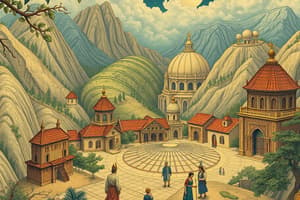Podcast
Questions and Answers
What is the primary focus of Physical Geography?
What is the primary focus of Physical Geography?
- Human activities and their impact on the planet.
- Geopolitics and territorial disputes.
- Cultural traditions and their distribution.
- Natural features and processes. (correct)
Which map projection is known for preserving angles but distorting size near the poles?
Which map projection is known for preserving angles but distorting size near the poles?
- Robinson Projection
- Peters Projection
- Mercator Projection (correct)
- Azimuthal Projection
What is the significance of Geographic Information Systems (GIS)?
What is the significance of Geographic Information Systems (GIS)?
- It studies demographics and migration patterns.
- It represents the Earth's surface on a flat map.
- It captures, analyzes, and manages spatial data. (correct)
- It measures climate zones around the world.
Which characteristic defines the organization of regions in geography?
Which characteristic defines the organization of regions in geography?
What type of biomes does Physical Geography study?
What type of biomes does Physical Geography study?
Which climate zone is characterized by high temperatures and seasonal rainfall?
Which climate zone is characterized by high temperatures and seasonal rainfall?
Which environmental issue is primarily driven by human expansion into urban areas?
Which environmental issue is primarily driven by human expansion into urban areas?
What is the purpose of using scale on a map?
What is the purpose of using scale on a map?
Flashcards are hidden until you start studying
Study Notes
Definition of Geography
- Study of Earth's landscapes, environments, and the relationships between people and their environments.
- Divided into two main branches: Physical Geography and Human Geography.
Physical Geography
- Focuses on natural features and processes.
- Landforms: Mountains, valleys, plains, plateaus.
- Climate: Weather patterns, climate zones (tropical, temperate, polar).
- Ecosystems: Biomes like forests, deserts, grasslands.
- Hydrology: Study of water bodies, rivers, lakes, and their distribution.
Human Geography
- Examines human activities and their impact on the planet.
- Population: Demographics, migration, urbanization.
- Culture: Language, religion, traditions, and their spatial distribution.
- Economics: Land use, agriculture, industry, trade.
- Politics: Geopolitics, territorial disputes, and governance.
Geographic Information Systems (GIS)
- Technology for capturing, analyzing, and managing spatial data.
- Applications in urban planning, resource management, and environmental monitoring.
Map Projections
- Methods to represent the curved surface of the Earth on a flat surface.
- Mercator Projection: Preserves angles; distorts size, especially near poles.
- Robinson Projection: Balances size and shape; used for world maps.
- Peters Projection: Emphasizes size accuracy; distorts shape.
Key Concepts
- Latitude and Longitude: System for locating points on Earth.
- Latitude: Measures north or south of the equator.
- Longitude: Measures east or west of the Prime Meridian.
- Scale: The relationship between distance on a map and actual distance on Earth.
- Region: Areas defined by certain characteristics (cultural, physical, economic).
Major Geographic Regions
- Continents: Asia, Africa, North America, South America, Antarctica, Europe, Australia.
- Climate Zones: Tropical, arid, temperate, continental, polar.
- Biomes: Tundra, taiga, temperate forest, grassland, desert, savanna.
Environmental Issues
- Climate change: Global warming and its impacts.
- Deforestation: Loss of forests and biodiversity.
- Urbanization: Growth of cities and its effects on the environment.
Study Techniques
- Use maps and globes to understand geographical concepts.
- Engage with GIS tools for practical applications.
- Explore case studies to comprehend human-environment interactions.
Definition of Geography
- Examines Earth's landscapes, environments, and human-environment relationships.
- Two main branches: Physical Geography (natural features) and Human Geography (human activities).
Physical Geography
- Investigates natural features and processes.
- Landforms: Includes mountains, valleys, plains, and plateaus.
- Climate: Analyzes weather patterns and climate zones, including tropical, temperate, and polar.
- Ecosystems: Studies various biomes, such as forests, deserts, and grasslands.
- Hydrology: Focuses on the distribution and characteristics of water bodies, including rivers and lakes.
Human Geography
- Focuses on human activities and their environmental impacts.
- Population: Involves demographics, migration trends, and urbanization.
- Culture: Covers languages, religions, traditions, and their geographical spread.
- Economics: Looks at land use patterns, agriculture, industry, and trade relations.
- Politics: Examines geopolitical factors, territorial disputes, and governance structures.
Geographic Information Systems (GIS)
- A technology used for capturing, analyzing, and managing spatial data.
- Applications span urban planning, resource management, and environmental monitoring.
Map Projections
- Techniques for translating the Earth's curved surface into flat maps.
- Mercator Projection: Maintains angles but distorts size, particularly at polar regions.
- Robinson Projection: Balances size and shape representation; commonly used for world maps.
- Peters Projection: Prioritizes size accuracy while distorting shape.
Key Concepts
- Latitude and Longitude: Coordinates for pinpointing locations on Earth.
- Latitude measures distance north or south of the equator, while longitude measures east or west of the Prime Meridian.
- Scale: Illustrates the relationship between map distance and actual ground distance.
- Region: Defined areas based on shared characteristics (cultural, physical, economic).
Major Geographic Regions
- Continents: Includes Asia, Africa, North America, South America, Antarctica, Europe, and Australia.
- Climate Zones: Varieties include tropical, arid, temperate, continental, and polar.
- Biomes: Encompasses tundra, taiga, temperate forests, grasslands, deserts, and savannas.
Environmental Issues
- Climate Change: Associated with global warming and its various impacts on ecosystems.
- Deforestation: Leads to significant loss of forests and biodiversity.
- Urbanization: Involves city growth and its consequential environmental effects.
Study Techniques
- Utilize maps and globes to better grasp geographical concepts.
- Engage with GIS tools for hands-on applications and analyses.
- Explore case studies to understand the dynamics of human-environment interactions.
Studying That Suits You
Use AI to generate personalized quizzes and flashcards to suit your learning preferences.




